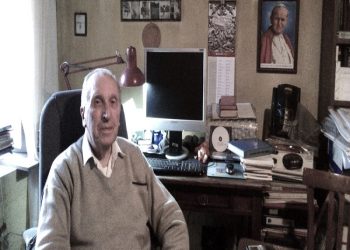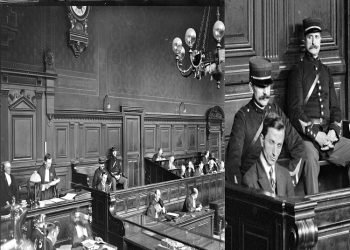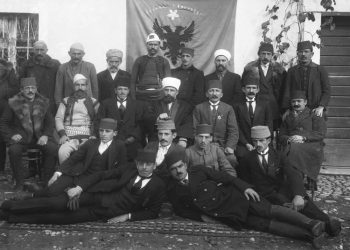By Prof. Gjon Frani Ivezaj
Memorie.al / As mother history teaches us, Malësia e Madhe has always been the subject of successive wars against foreign invaders for centuries, a land that has generated men of the rifle and loyalty, bravery and patriotism. In the volumes of documents on the history of the Albanian people, the name of Kelmend appears in the early centuries of the Middle Ages, in several languages, in several forms and in several spatial, geographical, cultural, historical, substantive and linguistic dimensions: Clemens, Klementi, Klimenti, Clementiner, Klemen, Klemente, Kelmendi and even Saint Peter, Pope Clement I, etc.
Its linguistic features are related to the name of the ethnographic region of Kelmend in Northern Albania, with the name of the Kelmend tribe, extending further throughout the Albanian and Balkan space. There is an extremely large number of sources, documents, reports, bulls, etc., which deal with Northern Albania in general and Kelmendi and the Kelmendi people in particular.
The documents that deal in depth with the history of Kelmendi are the reports of apostolic visitors, whether Albanian or foreign clerics, on the one hand, while, on the other hand, there are papal documents issued by the Holy See, such as, for example, the document from the Lateran Register fund dated December 14, 1401, with which Pope Boniface IX writes to Migliarino Manfredi de Fontana, the newly elected bishop of Shkodra, to pay special attention to the region of Kelmendi and in particular: “the Kelmendi people, who are very faithful and humble in faith, virtuous in life and very hospitable”.
On this occasion, the Bishop of Shkodra is requested to personally visit this region and to “help by all means to establish one or two assemblies of Franciscan friars there, where young people interested in the Kelmendi resisted for about five centuries against the Ottoman Empire”. This resistance of the Kelmendi has continued from generation to generation until our days, giving glory and pride to the name of their country. In the beautiful Albanian Alps, there is the famous region of Kelmendi. The ethnic inhabitants of this tribe have lived and continue to live around the two sources of the Cem River, Vukli and Selca, and the Vermoshi River.
Kelmendi, although known as a mountain, has been divided into four bajraqs. The name of the tribe comes from the Latin word clemens(tis), which means wise, simple, good. For the first time, in today’s sense, as a personal name, we meet it in the third deputy of Saint Peter, Pope Clement I, who, preaching the word of Christ among the pagans, was martyred. After the fall of Medun and Shkodra in 1457, the invading Ottoman army slowly managed to extend its power to the areas of the Greater Highlands. The Kelmends, despite the great difficulties they faced, remained unyielding, not paying any kind of obligation to the invader until 1664.
But all this, as well as many other threats and murders that were made to this tribe by the invaders, did not deter these brave men side by side with Hot, Grudë Kastrat, Shkrel and Shala. Bajraktari Mark Toma, was born in Selcë of Kelmend, a province very well known for patriotic men, brave of the rifle and faith, for the defense of the ethnic Albanian lands and the province of Kelmend from the predatory intentions of the foreign Turkish and Serbo-Montenegrin invaders. This young man, with positive tendencies as a patriot, smart, brave and loyal to tradition, like his predecessors, the province of Kelmend bestowed upon him the title; Bajraktari of Kelmend. He was a witness and participant in many wars for freedom and independence of the Albanian lands. Furthermore, we learn from historical sources that the captain of Kelmend, Mark Toma, at the age of 20, was put in charge of the brave and distinguished men of Kelmend, where he became known throughout the Highlands.
For his great contribution to the Albanian cause, the King of the Albanians, Ahmet Zog I, seeing his abilities, promoted him from a young age, with the title: Captain of the First Class. Mark Toma, inspired by patriotic ideas, proved to be an invincible brave man, never flinching, always fighting with unparalleled heroism against the cruel occupying armies of the Ottoman Empire, commanded at that time by Et’hem Pasha in Suka i Mkushti, where a bloody battle took place on April 25, 1911. The well-armed Turkish army, seeing the heroism of the local mountaineers, was forced to retreat in shame, fleeing towards the city of Shkodra, where all the Turkish garrisons were stationed, commanded by Riza Pasha. Hundreds of Ottoman soldiers were killed there, many of them were wounded and some were taken prisoner of war. Their weapons were distributed to the brave mountaineers.
The Turks were strong-willed and wanted to do what they wanted against the mountaineers and the Great Highlands. As always, the subjugation by any means and means of the pride of the Albanian highlanders was the main objective of the invading Ottomans. Thus, the Turkish army, very well armed with the weapons of the time, under the leadership of the cruel commander, Emin Pasha from Gucia, on April 28, 1911, tried to return to their bases in the Predalec Pass, but the brave mountaineers of Selca, led by their Bannerman Mark Toma, ambushed them and forced them to turn back the way they had come. The Asian Ottoman invaders left over 150 soldiers killed and many other mountaineers to be armed, to be ready for other attacks that the army of the Empire in question could undertake in the Kelmendi area.
The heroic resistance of the Albanian highlanders was very great. Thus, on March 19, 1911, the brave men of Kelmendi, with the brave bajraktars Mark Toma, Prek Cali, blocked the Turkish commander Et’hem Pasha, who was coming from Gucia, to join the other Ottoman troops of Shefqet Pasha. In this created situation, a great war took place, between the highlanders who fought to defend the Albanian lands and the invading Turkish army, in the mountainous area of Lepushë and Kashticë, where again the Ottoman army suffered very heavy losses in men and weapons. Also on June 5, 1911, a great and bloody war took place in Selca of Kelmendi, where the Turkish army with numerous forces was stretched along the Cemi River and Broja e Vukli.
As always, this time the brave invincible highlanders of Kelmendi, led as always by the bajraktars quoted above, severely damaged the Turkish army. The history of the people of the Highlands is filled with many events and dates, prominent figures, who are the honor and pride of the Highlands and all ethnic Albanian lands. Successive wars followed in the following days. Thus, the brave highlanders never forget the heroic wars on June 8, 9, 10, 13 and 14, 1911. The Highlanders stood up and grabbed their rifles to defend Kelmedin, not allowing the Turks to enter their territory. And the invincible eagles, as always, achieved their final goal.
Bajraktari Mak Toma Pllumbaj, with all the Highlanders, actively participated with rifle in hand in the 1911 Uprising, led by many other brave mountaineers, raising the red and black flag of freedom, with the two-proud eagle of the National Hero Gjergj Gjon Kastritot, on the top of the Deçiqi peak. All those brave and noble mountaineers, his close comrades-in-arms, remember that he was always with the red and black flag in his hand. Their house was well-known throughout Northern Albania for its generosity, rifle, faith, bravery, intelligence, patriotism and typical Albanian hospitality. The tradition of patriotism, bravery, generosity, faith and wisdom comes from the fact that Mark Toma and his family, generation after generation, was a great door of Selca e Kelmendi.
Anyone who has met this invincible brave man has seen in him the best qualities of an Albanian with tradition, being a great friend and lover to his friends and relatives and a rifle raised for freedom and independence, of the ethnic Albanian lands.
The Kelmendi bannerman Mark Toma Pllumbaj, was always at the forefront of the successive uprisings of the Kelmendi people in aid of the city of Shkodra, in the war against the Sublime Porte and the Serbo-Montenegrin Slavs in 1913. But the barefoot and naked mountain braves, without food or drink, without proper armament, could not withstand the long battles of the pro-Slavic red hordes. The distinguished bannerman Mark Toma, participated in the uprising of the Kelmendi braves against the army of Mark Milan, to defend our Illyrian-Arbër lands.
According to the memories of the elderly men of the Highlands, we learn that Marku was the right-hand man of the distinguished patriot and patriot, the Albanian nationalist brothers Gjeto and Dede Coku, as well as many other fighters for the freedom and independence of our country. The distinguished bannerman was at the forefront of the brave Highlanders in the Battle of Shkodra in 1913, against the Serbian and Montenegrin army, which sought to conquer Albanian lands. Marku also showed great examples of heroism in another battle that has gone down in history under the name of the Battle of Koplik, in 1920. The bannerman of Kelmendi, Mark Toma, was always ready with a rifle in his hand, for new wars and battles, against any enemy. He participated in all meetings with the distinguished leaders of the Greater Highlands, who discussed the high issues of the Fatherland and the protection of the borders from the predatory intentions of the Serbian and Montenegrin neighbors.
He often met and talked with the brave men of Shala, Dukagjin (Malësi e Madhe), Shkodra, Lezha, etc., in the chambers of the men of Malësia and in the city of Shkodra, where he often met and talked with the high nobility of the city and representatives of the Albanian Catholic Clergy. Another bloody war is very well remembered by the highlanders and the history of the Albanian people. Thus in 1923, the army destroyed everything they saw in Malësia. In the War of Dobrina, at the head of the brave highlanders, was the brave leader, the bajraktari of Kelmendi Mark Toma, where he showed unparalleled heroism. In that bloody battle, many brave highlanders were seriously wounded, among whom was the brave Uc Turku from Selca of Kelmendi…! Events were developing rapidly in the Albanian lands. With the arrival of communism in Albanian lands, Bajraktari Mark Toma was targeted by the communist party, whose main goal was to arrest and kill, with or without trial, all true nationalists and patriots, to make it easier to subjugate the highlanders and Malësia.
Thus, after the bloody battle of January 1945 at the Rrjollit Bridge, where the brave men of Kelmendi, Kastrati, Hoti, Shkreli and Bajza, etc. participated, the highlanders suffered heavy defeats, and for them a new ordeal began, where hundreds of highlanders were shot with and without trial, from Koplik, Bajza to the peaks of Vermoshi. Almost the entire Highlanders rose to their feet and organized for resistance. Thus, Kelmendi was led by the bajraktari Mark Toma, Prek Cali, etc., who, on January 1 of the same year, gathered all three of his bajrakts: Selcë, Nikç and Vukel, and with 150 men, took up position on the right bank of the Tamara Bridge. For about a month, he stopped the advance of the so-called First Albanian Partisan Brigade, which, together with the allied communist Serbian-Montenegrin forces, wreaked havoc, shedding the blood of the Albanian highlanders.
They, as if hungry, killed and destroyed, burned and plundered and shot with fire and iron the people and princes and brave men of Kelmendi, among them they shot the brave and patriot of the Albanian nation, who fought during his life for the freedom and existence of the Albanian nation, against our centuries-old, Turkish, Serbian-Montenegrin hostilities, where the brave and patriot of the Albanian nation, Prëk Cali, was shot in the sand of Kiri in 1945, by the Stalinist communist dictatorship and terror, where with blood and fire they wanted to conquer the iron shield of the Albanian race – the Highlands. Thus, the house of the bajraktar in Kelmend in Malësia was monitored day and night, who entered and left, who Marku spoke to and which mountaineer he associated with. His life and that of his family were becoming more and more difficult every day.
In these unfavorable conditions and with danger to his life and family, he and some anti-communist friends thought of a detailed plan to escape from Albania and escape to the free world, where freedom and democracy were enjoyed by all.
The communist state security of the dictatorship of the proletariat was on its feet, to arrest Marku and many friends of anti-communist ideals in Albania, Shkodra and Malësia e Madhe at all costs. With 50 other nationalist mountaineer men and citizens of Shkodra, the bajraktar of Kelmend Mark Toma, in 1948 escaped towards Yugoslavia. He loved his homeland and his birthplace in the Highlands very much. Marku had no desire to go abroad, but the brutal communist regime forced him to leave his ancestral land and family. Marku felt very sorry for his people, his beloved family, whom he had cared for for many years.
The dictator Enver Hoxha hated the Highlanders, because he knew very well that they had never submitted to any invader and had no intention of submitting to his anti-Albanian regime, no matter how brutal it was. Marku was known for his skill, intelligence, wisdom, hospitality, faith and typical highland manhood. The Kelmendi bannerman was honored by all of the Highlands, Shkodra and Albania, because the Kelmendi Region was at the forefront of the resistance war against the new communist regime of the dictator Enver Hoxha. The bannerman initially went to Tuz in Yugoslavia. There he found hospitality, trust, and generosity from his Albanian brothers, who understood the difficult situation Albania was going through due to the establishment of the communist dictatorship, which was killing every day the best sons of the Albanian people, who were against the Bolshevik communist ideology.
Marku, had crossed the Albanian-Albanian border, together with his two sons, Gjon and Nikolla, while the other two sons, Pashku and Rroku, remained in Albania. The flag bearer Mark Toma, throughout Malësia e Madhe, was very honored and respected, as well as from other regions such as Plavë and Guci, Ulcinj and Tivar. He participated in many cases for the reconciliation of blood feuds, among the mountaineers, who had long been confined to their homes due to enmity. He saw the death of his 30-year-old son, from an incurable disease. Although with great pain in his soul, he and his family stood like men, turning pain into strength, a tradition inherited throughout Malësia. Mark Toma as a flag bearer, died at the age of 78 in Tuz in Malësia e Madhe, having seen the freedom of Albania and the fall of black communism. During his life full of wars and survival, he experienced Kelmendi in blood and rope and in prisons, in suffering and other difficulties of life, caused by the communist dictatorship of Enver Hoxha.
For the death of the Kelmendi Bannerman Mark Toma, the whole of Malësia shed tears. He was buried with honors and magnificent ceremonies by the mountaineers, who accompanied him to his last home, in the Shipshanik cemetery in Tuz, where even today his remains rest in peace and grace…! The path of the well-known door of the Kelmendi Bannerman Mark Toma Pllumbaj, was followed with honor, generosity, tradition and hospitality according to Albanian customs and traditions by his son, Nikollë Mark Toma, a brave young man with a generous heart. Moreover, the son of the Kelmendi Bannerman was a witness to many joys, both in Malësia e majeste and within the Albanian American community. A characteristic of the house of the bajraktar is that they have always been distinguished for their bravery and generosity, expressed in every case that people have asked for help, hospitality with a pure Albanian heart for all friends, well-wishers and occasional guests, who have stayed in the guest house filled every evening with highlanders, bravery expressed in every war and effort to lovingly preserve the lands of our ancestors, etc.
Nikolla, since he was young in Kelmend, as many of his friends and comrades remember, has had ardent patriotic feelings close to his heart, he spoke with passion and respect for the glorious history of the distinguished men of Kelmend, their heroism throughout the centuries, their ardent desires for freedom and independence. Nikolla, as a great and tireless activist of the Albanian cause, actively participated in many anti-communist demonstrations that were organized in front of the UN and the White House in Washington, D.C. He also participated in demonstrations on the issue of Kosovo, against the centuries-old Serbo-Montenegrin colonizers. Thanks to his great generosity of spirit, he contributed a lot in financial and material aid, to rebuild churches, schools, as centers of Albanian knowledge and culture, as well as much other humanitarian aid in the Highlands and Albania. Bajraktari Nikollë Mark Toma, hearing the suffering of his family in Kelmend from other highland refugees from Albania, in the most difficult days of the dictatorship, in cold winter weather and the army, risking his head in front of the armed army of the communist State Security, well-armed, entered the border of Albania, in Selcë of Kelmend.
After many efforts, he went to his home, where he took his brother Pashku with him, and again amidst the great difficulties of the snowy weather, and the rugged mountainous terrain of the Northern Albanian Alps, and with great care not to be discovered by the border patrol forces, he took the path back to Tuz in the Highlands. Thus, the memories of Nikola’s life and work have been passed down from mouth to mouth, in the halls of the men of the Highlands from generation to generation until our days. In 2015, in New York, USA, the prominent patriot, the flag bearer of Kelmendi, Nikola Mark Toma, passed away, where his funeral ceremony was attended by many Catholic clergy, the Albanian ambassador to the USA, Muslim clergy, and other Albanians regardless of religion, region, idea, living in New York, Detroit, etc., as well as family members and patriots from Albania, Montenegro, etc. Today his remains rest in New York State. Memorie.al




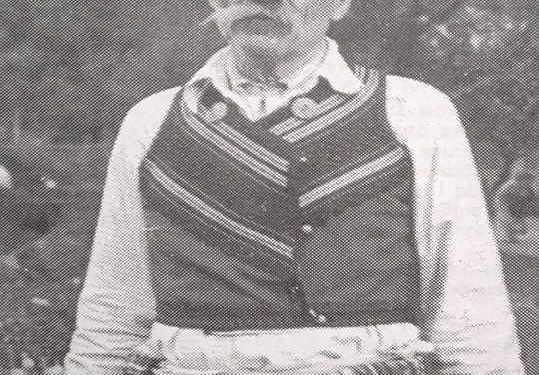
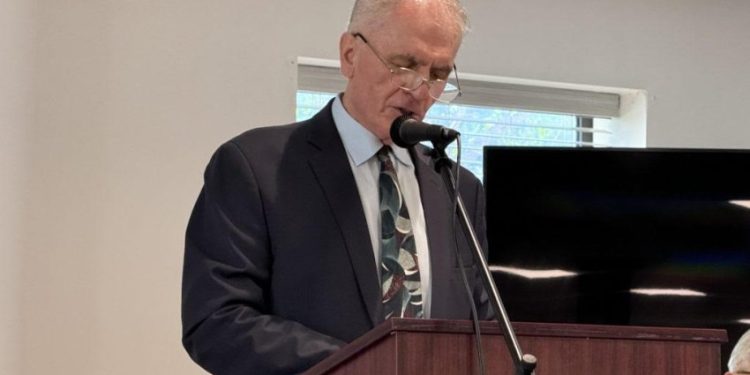
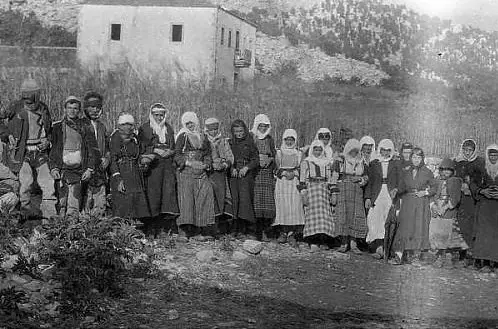
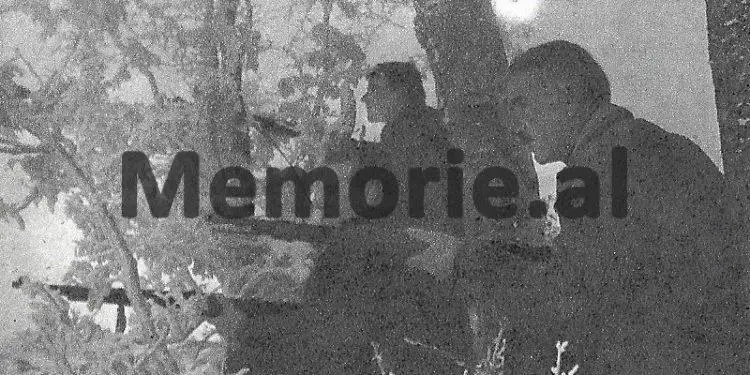
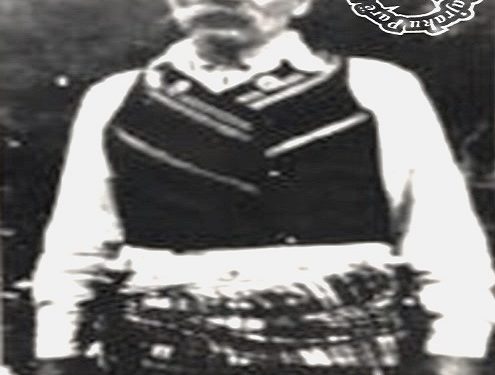
![“We hosted the German friend with wine, ‘Moskat’ raki that Enver [Hoxha] used to drink, but in his villa, he told me: ‘Hey Belul, who told you to accompany Strauss…?’”/ The rare testimony of the former Chairman of the Pogradec Committee](https://memorie.al/wp-content/uploads/2025/11/jozef-shtarus-350x250.jpg)

